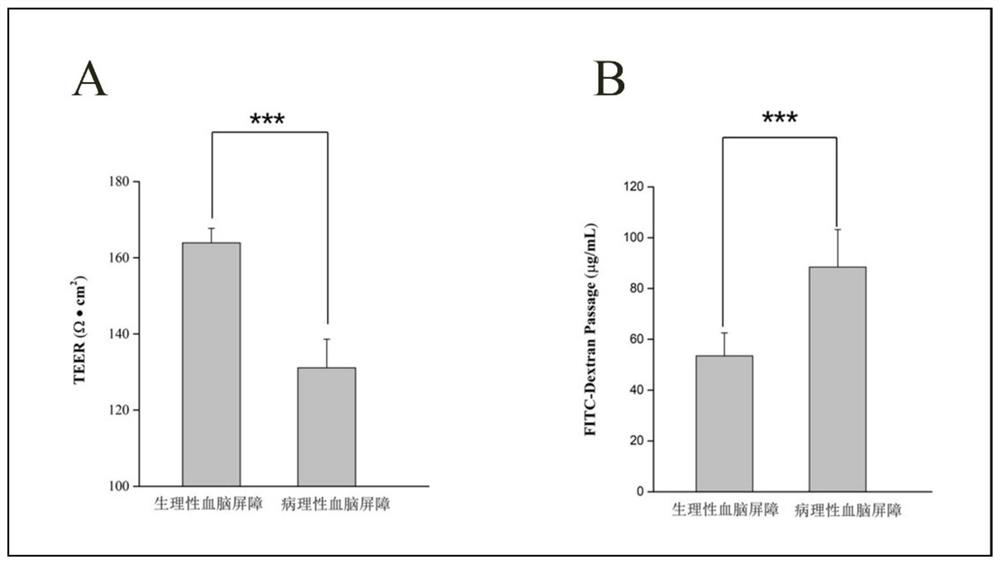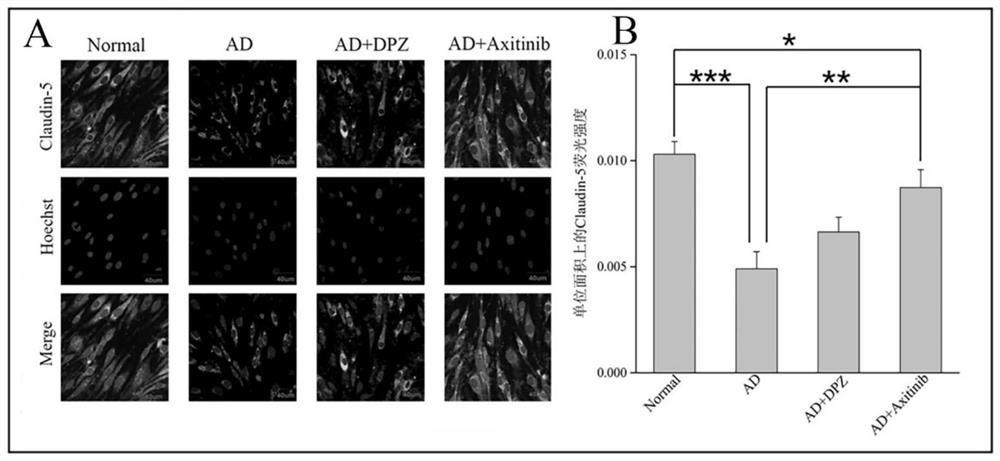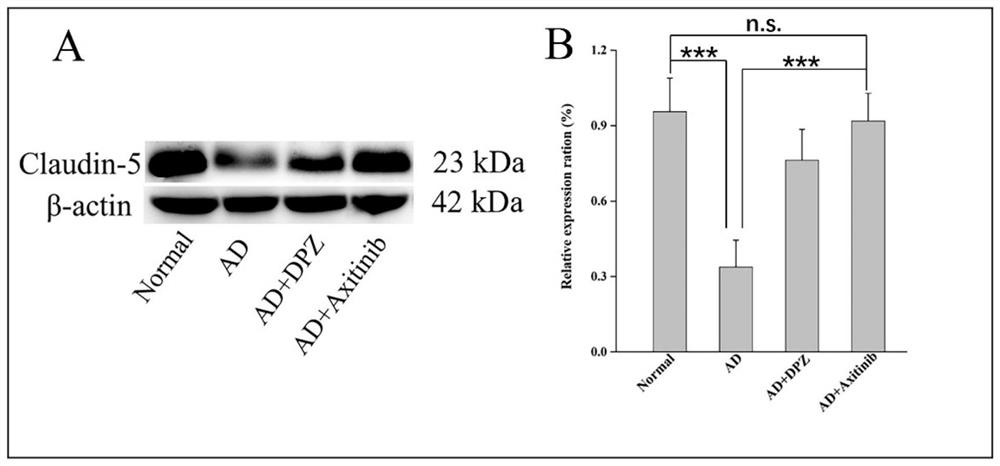Application of VEGFR inhibitor in preparation of anti-Alzheimer's disease medicine
A technology of inhibitors and anti-inflammatory drugs, applied in the field of biopharmaceuticals, can solve problems such as aggravating disease progression, achieve the effects of restoring blood-brain barrier function, improving learning and memory ability and learning and memory behavior, and reducing blood-brain barrier permeability
- Summary
- Abstract
- Description
- Claims
- Application Information
AI Technical Summary
Problems solved by technology
Method used
Image
Examples
Embodiment 1
[0024] Example 1 Alzheimer's disease causes functional damage to the blood-brain barrier
[0025] 1.1 Construction of physiological blood-brain barrier cell model
[0026] Using mouse-derived brain microvascular endothelial cells bEnd.3 as model cells, take 0.5 mL of bEnd.3 cell suspension in good growth state and inoculate it in a 12-well Transwell plate chamber with a pore size of 0.4 μm at a seeding density of 1×10 5 Each well, add 1.5mL fresh culture medium to the outer chamber, 37°C, 5% CO 2 The culture was continued for 15 days under the same conditions, and the fresh culture medium was replaced every other day. Use a cell resistance meter to measure the cell transmembrane resistance value, when the transmembrane resistance value is greater than 150 ohm square centimeter (Ω cm 2 ), which is a physiological blood-brain barrier cell model.
[0027] 1.2 Construction of pathological blood-brain barrier cell model
[0028] Taking bEnd.3 and PC-12 as model cells, take ...
Embodiment 2
[0032] Example 2 Axitinib up-regulates tight junction proteins in brain microvascular endothelial cells and restores blood-brain barrier function
[0033] 2.1 Immunofluorescence detection of tight junction protein expression in each group
[0034] Dilute bEnd.3 cells at 1 × 10 5 The density of cells / well was seeded in a 24-well plate with cell slides, and the cells were placed at 37°C, 5% CO 2 Cultured continuously for 7 days. The experimental groups were Normal group, AD group, AD+DPZ group, and AD+Axitinib group. Normal cultured cells in the Normal group; the latter three groups were treated with Aβ 1-42 Incubate for 24 hours, and then add donepezil or axitinib for another 24 hours. After that, the cells were washed 3 times with PBS, fixed with 4% formaldehyde, blocked with 10% bovine serum albumin for half an hour, added the primary antibody of tight junction protein Claudin-5 (1:200, monoclonal antibody, Invitrogen Company) and incubated overnight at 4°C . After wa...
Embodiment 3
[0038] Example 3 Axitinib regulates blood-brain barrier permeability in Alzheimer's disease model animals
[0039] 3.1 Construction of Alzheimer's disease model animals
[0040] Male C57 / BL6 mice (10w-12w) were selected as model animals, and Aβ at a concentration of 1 mg / mL was injected with the aid of a stereotaxic instrument. 1-42 The oligomer was injected into the hippocampus of the mouse (the injection coordinates were 2.3 mm behind the bregma, 1.8 mm to the right, and the depth was 2 mm), the injection volume was 5 μL / mouse, and the injection time was 5 minutes. After the injection, sutures were completed on the surface of the skull, and the operated mice were kept in an SPF-grade environment for one week to construct Alzheimer's disease model animals.
[0041] 3.2 After axitinib treatment, the penetration of Evans blue in the brain of Alzheimer's disease model animals was significantly reduced
[0042] Animals were grouped as follows: Normal group, AD group, AD+DPZ...
PUM
| Property | Measurement | Unit |
|---|---|---|
| molecular weight | aaaaa | aaaaa |
| concentration | aaaaa | aaaaa |
Abstract
Description
Claims
Application Information
 Login to View More
Login to View More - R&D
- Intellectual Property
- Life Sciences
- Materials
- Tech Scout
- Unparalleled Data Quality
- Higher Quality Content
- 60% Fewer Hallucinations
Browse by: Latest US Patents, China's latest patents, Technical Efficacy Thesaurus, Application Domain, Technology Topic, Popular Technical Reports.
© 2025 PatSnap. All rights reserved.Legal|Privacy policy|Modern Slavery Act Transparency Statement|Sitemap|About US| Contact US: help@patsnap.com



